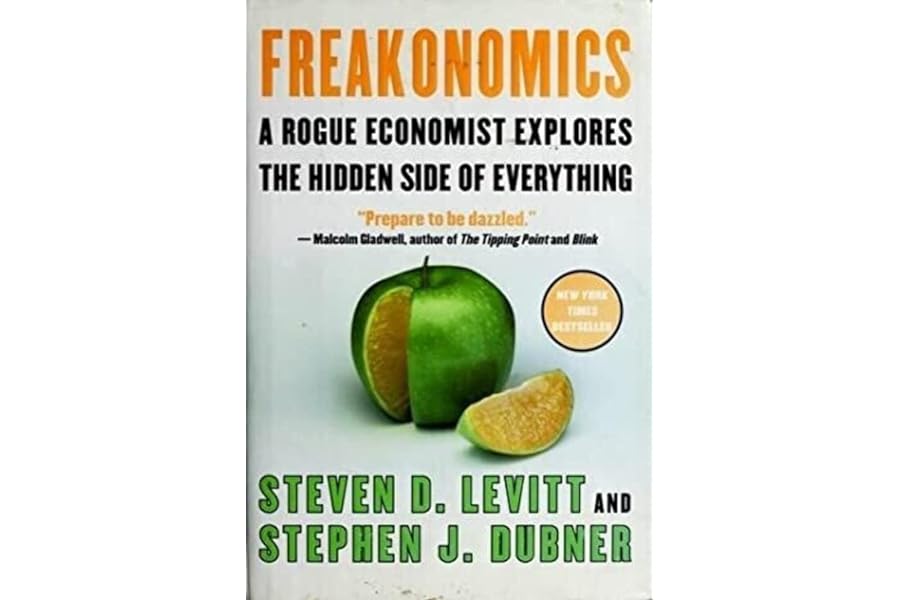One sentence summary:
Straying from conventional economic theories, ‘Freakonomics’ explores the hidden side of various social phenomena and uncovers surprising connections using data and unexpected insights.
Book genre:
Non-fiction, economics, social science, popular science, popular culture.
Main topic of the book:
The book delves into the study of human behavior, using the tools of economics and data analysis to uncover the hidden connections between seemingly unrelated events and human actions.
Key ideas:
- Conventional economic theories are inadequate in explaining human behaviour and social phenomena.
- Data analysis and studying incentives can provide valuable insights into understanding human behaviour.
- Concepts such as incentives, information asymmetry, and unintended consequences play a significant role in shaping people’s decisions.
- The book explores unconventional topics such as the economics of drug dealing, cheating in sumo wrestling, and the impact of parenting on children’s success.
- To truly understand a situation, one must think like a detective and look for the hidden side of things.
Main parts of the book and short summary:
Introduction:
The authors introduce the book, discussing the unconventional methods and ideas used to explore various social phenomena and question conventional wisdom.
Chapter 1 – “What Do Schoolteachers and Sumo Wrestlers Have in Common?”:
This chapter examines the role of incentives in driving human behavior, using the examples of cheating teachers and sumo wrestlers to illustrate how incentives can lead people to make unethical decisions.
Chapter 2 – “How is the Ku Klux Klan Like a Group of Real-Estate Agents?”:
This chapter explores the concept of information asymmetry, where one party has more information than the other, and how it can be used to manipulate people’s decisions. The authors use the example of the Ku Klux Klan and real estate agents to demonstrate this concept.
Chapter 3 – “Why Do Drug Dealers Still Live with Their Moms?”:
This chapter challenges the common belief that drug dealing is a lucrative and glamorous profession, and instead presents evidence that most drug dealers make very little money. The authors use an economic analysis to uncover the incentives and structures that keep drug dealers in the business.
Chapter 4 – “Where Have All the Criminals Gone?”:
This chapter looks at the sharp decline in crime rates in the 1990s and provides evidence that it was not due to increased police presence or stricter punishments but was mainly attributed to legalized abortion leading to fewer unwanted children growing up in disadvantaged households.
Chapter 5 – “What Makes a Perfect Parent?”:
The authors use data analysis to challenge popular beliefs about the impact of parenting on children’s success and suggest that it may not be as influential as many think.
Chapter 6 – “Perfect Parenting, Part II; or: Would a Roshanda by Any Other Name Smell as Sweet?”:
In this chapter, the authors continue to explore the impact of parenting on children’s success, discussing the relationship between a child’s name and their future success.
Chapter 7 – “The Sibling Effect”:
This chapter looks at the impact of birth order on children’s success, challenging conventional wisdom and providing evidence that second-born children may have a higher likelihood of engaging in risky behaviors.
Chapter 8 – “The Economics of Parenting, Part III”:
In the final chapter, the authors use an economic analysis to examine how parents can use incentives to motivate their children to succeed.
Key takeaways:
- The book challenges conventional wisdom and provides unique insights into various social phenomena using unconventional methods and data analysis.
- Incentives, information asymmetry, and unintended consequences play a significant role in shaping human behavior.
- By thinking like a detective and looking for the hidden side of things, we can gain a better understanding of social phenomena and human behavior.
- Data and economic analysis can provide valuable insights into understanding human behavior, even in unconventional areas such as drug dealing and parenting.
Author’s background and qualifications:
Steven D. Levitt is an American economist and professor at the University of Chicago, known for his research in the field of microeconomics and the applications of economic theory to diverse topics. Stephen J. Dubner is an American journalist and author, best known for his work on writing and broadcasting The New York Times’ Freakonomics column and podcast. Both authors have backgrounds in economics and data analysis, making them well-equipped to explore the hidden side of various social phenomena.
Target audience:
The book is suitable for a wide range of readers, from those interested in economics, social science, and data analysis to those interested in popular culture and human behavior. The authors present complex ideas in an engaging and accessible way, making it suitable for a general audience.
Publisher and first publication date:
Publishing house: William Morrow
First Publication date: April 12, 2005

